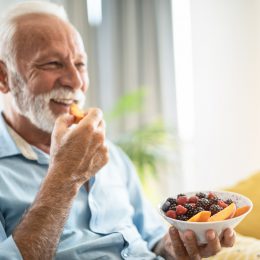5 Facts About the Exercise-Hunger Connection
It makes sense that moving around more could make you feel hungrier than usual. But nutrition and physical activity affect each other in more surprising ways.

Diet and exercise are the cornerstones of healthy weight loss. And they are often dependent on one other for success. In a study published in BMC Public Health, people who combined physical activity with dietary improvements were more successful at shedding pounds than those who only changed one behavior.
But when you pair those two things together, hungriness can become an issue. “Scientifically, our bodies want to keep us in a state of homeostasis, or balance,” says Hillary Ake, R.D., a board-certified specialist in sports dietetics.
“When we are in an energy deficit from exercise, there is an increase in ghrelin, which is a hormone that stimulates the desire to eat,” Ake explains.
So if burning more calories makes you want to eat more, how do you find the right balance to hit your weight-loss goals? For one thing, it helps to understand how exercise and hunger are connected. Spoiler alert: You may be surprised by what you read.
Stay active, have fun, get fit — with SilverSneakers! Classes and events are happening right now at participating gyms, online through SilverSneakers LIVE, and at community centers near you. Activate your free online account to get started.
Fact #1: Exercise Can Increase Your Appetite — or Lower It
You read that right, exercise can send your appetite in the other direction too. Common sense dictates we should be hungry after our workout, but there are exceptions to this rule.
Feeling ravenous after a workout may depend on how long and intense your exercise session is. A recent review in the journal Appetite suggests that shorter, higher-intensity sessions can temporarily blunt key hormones that make us feel hungry.
The same is true for the duration of exercise, says Roxana Ehsani, R.D., a board-certified specialist in sports dietetics. She says the longer you do an activity, the less likely you are to feel hungry afterward.
“As you exercise intensely or for long periods, your body must work hard to pump blood to your muscles, heart, and brain,” Roxani says. To keep that blood going where it needs to, your body puts the brakes on digestion — at least for the time being.
More studies are needed to fully grasp how or why exercise impacts appetite. While existing research can clue you in on how your hunger levels may be affected by exercise, your own experience may be different.
Fact #2: You Need More Calories Once You Start Exercising
You may notice that you’re hungrier than ever once you start exercising — even if you feel less hungry immediately after working out. So you’re eating more, but you’re trying to lose weight. How’s that going to work?
“Researchers seem to agree that, while exercise may increase appetite, it is likely not enough to compensate fully for the energy expended during exercise, and thus weight loss is still possible, even if you feel hungrier,” Ake says.
So don’t ignore your hunger. If your appetite is higher, fuel up on healthy foods to tide you over. We’ll give you much more detailed advice on what you should eat below.
Fact #3: You May Not Be Burning as Many Calories as You Think
It’s natural to think that if you’re exercising a lot, it’s OK that you’re eating more. And it is fine — as long as you’re estimating how many calories you’re burning accurately. But many people assume the calorie burn for that strength training or yoga class they attended is a lot higher than it actually is.
In a study in the Journal of Sports Medicine and Physical Fitness, participants in a group resistance-training class thought they burned 67% more calories on average than they actually did.
Fitness trackers can help, but don’t assume your smartwatch data is exactly on the money either. Fitness-tracker watches frequently overestimate calorie burn too, according to research from Stanford University. The findings revealed that the Apple Watch is the most accurate.
Fact #4: Protein Is Your Fullness Friend
Upping your overall protein intake is a healthy and smart way to tame increased hunger. This essential macronutrient keeps you feeling full longer than carbohydrates or fat, per a review in the American Journal of Clinical Nutrition.
Eating more protein has other major upsides for weight loss too. Protein prevents the loss of lean muscle,” says Ake. Seniors are more prone to losing muscle mass they age, so building and maintaining the muscle you have helps keep your metabolism revved.
Your exact protein needs may vary, but exercising adults should aim for 1.4 to 2 grams of protein per kilogram of body weight per day, says the International Society of Sports Nutrition. So, if you weigh 150 pounds, keep your protein intake between 95.2 and 136 grams spread evenly throughout the day. Foods that are are good sources of protein include seafood, meat, poultry, eggs, beans, peas, lentils, nuts, seeds, and soy products.
Subscribe to our newsletter
It's quick and easy. You could be one of the 13 million people who are eligible.
Already a member? Click to discover our 15,000+ participating locations.
Follow Us
Recommended reading: 10 Ways to Sneak More Protein Into Your Diet
Should You Use a Protein Powder?
Fact #5: Carbs Aren’t a Weight Loss Enemy
Certain popular low-carbohydrate diets like keto have given this micronutrient a bad rap. Eating carbohydrates is crucial when you’re exercising, since your muscles rely on a stored form of carbohydrates known as glycogen to power through a workout.
Exercise depletes those reserves, particularly if it’s high-intensity. If you don’t replenish those stores within an hour or so after your workout, you may overcompensate by eating too many carbs at your next meal — which is not the optimal menu for losing weight.
It’s a good idea to sneak in a carb-rich snack after a long or intense workout, but make sure your carb choices are mainly from produce or whole grains. Double up the good nutrition and pair them with protein, too. If you’re short on ideas of what that looks like, here are a few post-exercise bites for you to try:
- Fruit smoothie: handful of spinach, ½ banana, ½ cup berries, 1 cup Greek yogurt or kefir. For vegans or those who are lactose intolerant, try vegan protein powder and almond milk instead of dairy.
- Open-faced peanut butter sandwich: 1 slice whole grain bread + 2 tablespoons all-natural peanut butter + ½ sliced banana
- ½ cup cooked oatmeal + 1 hardboiled egg
See our sources:
Combining diet and physical activity: BMC Public Health
Exercise and appetite control: Appetite
Energy expenditure in group exercise classes: Journal of Sports Medicine and Physical Fitness
Accuracy of smartwatches: Journal of Personalized Medicine
Protein and satiety: American Journal of Clinical Nutrition
Daily protein intake: International Society of Sports Nutrition
Protein-rich foods: U.S. Department of Agriculture
Activate Your FREE SilverSneakers Online Account
Get hundreds of free SilverSneakers On-Demand videos and stay in touch with us by creating your free online account. You don’t have to be a SilverSneakers member to get on-demand workout videos, health and fitness tips from SilverSneakers, and more.
SilverSneakers members can go to thousands of nationwide gyms and fitness locations, plus take SilverSneakers LIVE online classes led by specially trained instructors and designed for all fitness levels and abilities – at no additional cost. If you have a Medicare Advantage plan, it may include SilverSneakers. Check your eligibility here.
Already a member? Get your SilverSneakers member ID, search for locations near you, and all the health and wellness resources you need by logging in to your online member account here.





